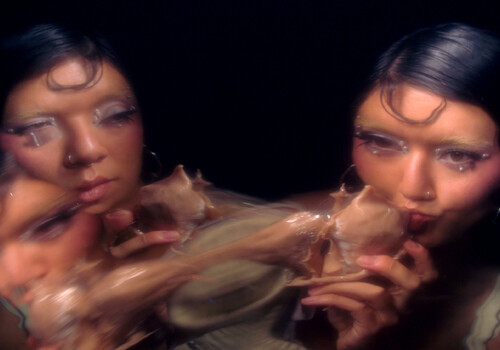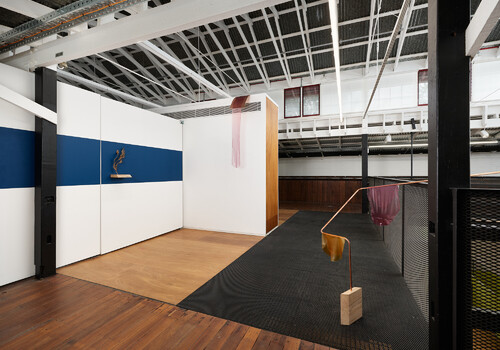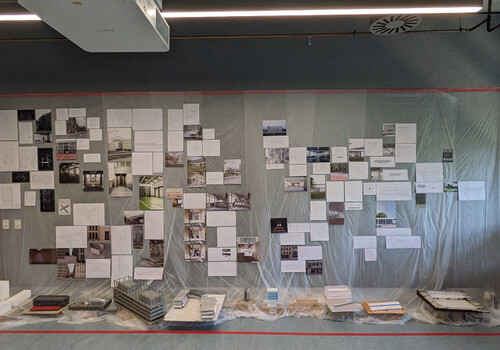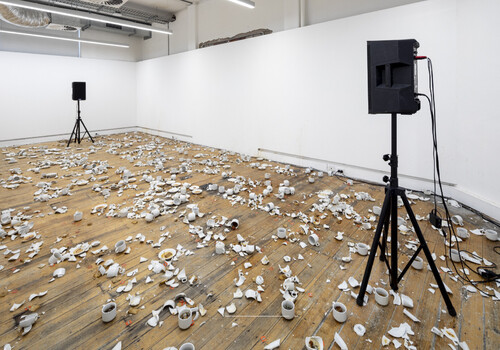Masters, Victorian College of the Arts
By Nadhila Iffa Zakira
Some of the most exciting work at this year’s VCA Grad Show treats the exhibition space itself as a key medium, investing it with an aura that influences how visitors experience the artworks within and communicates something of its own. Leo Bagus Purnomo’s massive installation, The Three Realms of Understanding: Embracing the Ineffable, took me inside a cave of fabrics suspended from the ceiling and covering the walls in layers of different arrangements. The photographs printed on the fabric feel as personal as individual memories, but also profoundly universal, representing shared human experiences. The images mix together a life cycle (childhood, college friends, and a traditional Indonesian wedding) with photographs of prehistoric animal paintings and keris, traditional Indonesian daggers, becoming a dialogue between individual and collective memories of society. Since I am Indonesian, I, too, share those experiences of its myths and history. Adding to this evocation of national myth, a soundtrack of traditional instruments and a symbolic pattern referencing Batik in the photos build up a calm, almost mystical atmosphere. The whole room made me feel like I had been transported to another space that I knew by heart. As I walked by, it left me wondering if other people would feel this connected with the work without intimate knowledge of its cultural context.

Leo Bagus Purnomo, The Three Realms of Understanding: Embracing the Ineffable, installation, looped audio, 2024. Photo: courtesy of the University of Melbourne
Hootan Heydari’s Looking Back, Again: An Embodied Exploration of Compulsion to Repeat as They Relate to Migrant Identity and Creative Practice is a room hung with ten artworks, the floor covered with one repeated Farsi word written in chalk. As the audience filled the room, the word slowly faded on the black floor; some left only faint marks in chalk dust, while others remained visible, signalling that no one had stepped on them. Where many contemporary interactive works are tech-driven, Heydari chooses to converse with the audience through the physicality of space, letting the floor change organically with the crowd’s movement. The blurring text suggests a human identity fading away each time it is stepped on and turned into something else. The ten artworks hung on the walls strengthen the references to Middle Eastern culture and identity: the same Farsi word repeated on the surface of cassettes, historical photographs, and white plaster cast pistachios. Each component of the work is tied together with a narrative of the migrant experience and the migrant’s compulsion to “repeat” their home culture.

Hootan Heydari, Looking Back, Again: An Embodied Exploration of Compulsion to Repeat as They Relate to Migrant Identity and Creative Practice, installation, photographs, looped audio, 2024. Photo: courtesy of the University of Melbourne
Spatial narratives whisper through every element of Purnomo and Heydari’s installations, each assigned its own aesthetic qualities and messages. In both artists’ work, the use of space highlights migrant identities and experiences, transporting us to a “space” that feels culturally, even geographically, elsewhere. In these works, space is not simply a physical container. Instead, it becomes a context of artistic exploration on a deeply personal level, influenced by broader social issues. Fittingly, this reflection came up inside the gallery walls, but while the Melbourne sun was burning my skin and cheeks, it stayed with me outside, too.
Coming from Indonesia, Nadhila Iffa Zakira is an emerging writer and visual storyteller with a deep focus on Southeast Asian contemporary art.









































